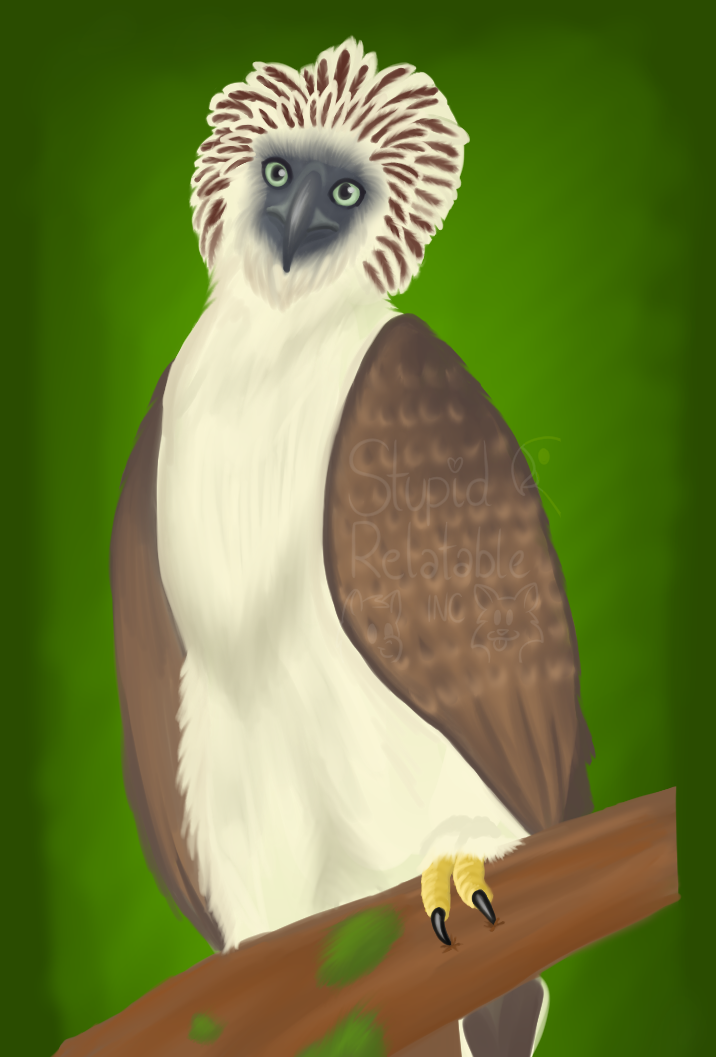Philippine Eagle
Philippine Eagle
Intro;
The Philippine Eagle (Pithecophaga jefferyi) also known as the monkey-eating eagle, is the largest forest raptor in the Philippines. Endemic to the Philippines forests, it's also the country's national bird.
These birds of prey sport an impressive 7ft wingspan, among the broadest of the world's forest raptors. Considered one of the largest and most powerful forest raptors worldwide, at 3ft tall from crest to tail, it's no surprise these predators pick off monkeys in the trees.
These raptors are listed as critically endangered, with an estimated 400 pairs living in the wild. It is important to note that these birds are strictly monogamous. Though if one mate dies, the other may find a new mate to spend the rest of their time with. They lay one egg every two years or so, as this is how long it takes for a chick to mature enough to leave the nest. Parent birds both take part in incubating the egg for roughly 60 days. The male raptor does a majority of the hunting during the first 40 or so days of the eaglet's life. These birds take between five and seven years to sexually mature.
Habitat;
Each pair needs about 4000 - 11000 hectares of forest to thrive. This is of course dependent on prey amount in the area. Being endemic to the Philippines means they're only found within. And even more incredible, of the 7000 islands of the Philippines, these eagles are only found on four of them. Luzon, Samar, Leyte, and Mindanao. The majority number of eagles live on Mindanao.
They favour steep areas, though survive in elevations from lowlands/sea level to mountains of over 1800m. Evolving without natural predators ensured Philippine Eagles the title of the dominant hunter in their surroundings. Their life expectancy is estimated to be between 30-60 years. Captive birds have been recorded living till their mid-40s.
Diet;
As stated above, these raptors have earned the nickname "monkey-eating eagle", as it was once thought that they almost exclusively ate monkeys, specifically two subspecies of macaque (Philippine long-tailed macaque, and the common long-tailed macaque).
This has since been proven inaccurate. The Philippine Eagle, like many predators, is an opportunistic hunter. They take prey based on abundance and ease of capture. Prey items documented in the eagle's nests range from bats to Philippine deer.
Primary prey items vary from island to island. For example, Philippine flying lemur are the preferred prey on Mindanao, but are completely absent in Luzon. As they are opportunistic hunters, they've been documented eating such things as civets, macaques, squirrels, bats, birds (owls and even other birds of prey), and reptiles. There have also been reports of Philippine Eagles capturing young pigs, and even small dogs.
Conservation & threats;
Unfortunately, many factors have contributed to the falling number of the Philippine Eagle. Though most prevalent is habitat loss. As more of their hunting grounds are cut down, and their livable area is forcibly smaller and smaller, they're left with few places to go. Fledglings must leave their parents and find their own areas to live. With prey being driven out as much as these predators, starvation is a more apparent survival issue.
Some birds unfortunately find themselves near humans. Which may result in being shot, or captured.
What can we do?
There are current conservation efforts in place to aid the survival of the Philippine Eagle. From education to breeding programs and nest observation. Rescue and rehabilitation centres are also available for injured or otherwise unwell birds, to give them a chance at life.
There are even those that volunteer their time to being forest guards. Replanting areas of forest, disarming and removing traps, and doing what they can to protect whats left from illegal logging practices.
Donations are accepted by Philippine Eagle Foundation, and The Peregrine Fund.
Sources;
https://www.philippineeaglefoundation.org/philippine-eagle
https://en.wikipedia.org/wiki/Philippine_eagle
https://www.peregrinefund.org/explore-raptors-species/eagles/philippine-eagle
Sources;
https://www.philippineeaglefoundation.org/philippine-eagle
https://en.wikipedia.org/wiki/Philippine_eagle
https://www.peregrinefund.org/explore-raptors-species/eagles/philippine-eagle
Submitted By Stupid_Relatable
for Jungle Expedition: Report
Submitted: 3 years ago ・
Last Updated: 3 years ago
